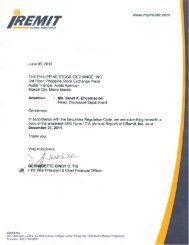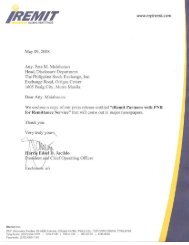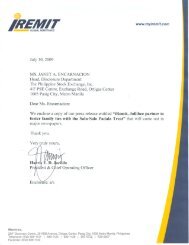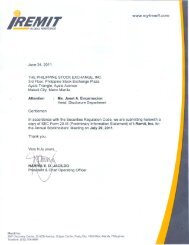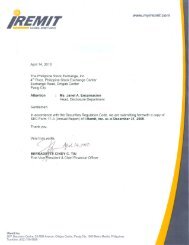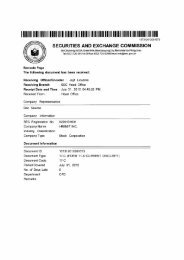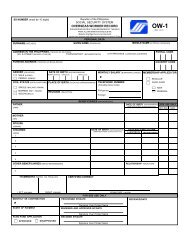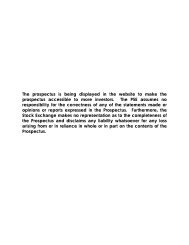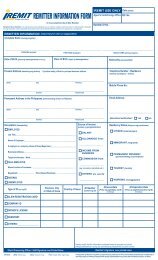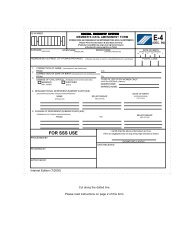- 21 - The main risks arising from the Parent Company’s financial instruments are credit risk, foreign currency risk, cash flow interest rate risk, and liquidity risk. The BOD reviews and approves policies for managing each of these risks and these are summarized below: Credit Risk Credit risk is the risk of loss resulting from the failure of a borrower or counterparty to perform its obligations during the life of the transaction. This includes risk of non-payment by borrowers or issuers, failed settlement of transactions and default on contracts. The nature of its business exposes the Parent Company to potential risk from difficulties in recovering transaction money from foreign partners. Receivables from foreign offices and agents arise as a result of its remittance operations in various regions of the globe. In order to address this, the Parent Company has maintained the following credit policies: (a) implement a contract that incorporates a bond and advance payment cover such that the full amount of the transaction will be credited to the Parent Company prior to their delivery to the beneficiaries, which applies generally to all new agents and in certain cases to old agents; (b) all foreign offices and agents must settle their accounts within the agreed credit terms, otherwise, the fulfillment or delivery of their remittance transactions will be put on hold; (c) evaluation of individual potential partners and preferred associates’ creditworthiness, as well as a close look into the other pertinent aspects of their partners’ businesses which assures the Parent Company of the financial soundness of their partner firms; and (d) receivable balances are monitored daily by the regional managers with the result that the Parent Company’s exposure to bad debts is not significant. The Parent Company’s receivables from agents and courier companies are highly collectible and have a turnover ranging from 1 to 5 days and 30 to 60 days, respectively. The other receivables, which include advances to related parties, are also highly collectible and are due in less than one year. The table below shows the maximum credit exposure of the Parent Company per account classification as of December 31, <strong>20</strong>11 and <strong>20</strong>10 (see Notes 6, 7, 8 and 12): <strong>20</strong>11 <strong>20</strong>10 Loans and receivables: Cash and cash equivalents* P=642,750,978 P=685,9<strong>20</strong>,368 Accounts receivable Other receivables 996,803,102 1,115,685,946 Related parties 137,260,244 97,767,888 Advances to officers and employees 2,526,259 2,991,428 Noncontrolling shareholders – 39,981,243 Others Other noncurrent assets 3,457,329 1,166,686 Refundable deposits 4,568,661 4,099,931 Total * excludes cash on hand P=1,787,366,573 P=1,947,613,490 *SGVMC116501*
- 22 - The table below shows the maximum credit exposure of the Parent Company per geographical classification as of December 31, <strong>20</strong>11 and <strong>20</strong>10: <strong>20</strong>11 <strong>20</strong>10 Asia Pacific P=1,386,607,212 P=1,742,336,664 North America 169,629,594 54,214,381 Europe 122,244,502 52,265,667 Middle East 108,885,265 98,796,778 Total P=1,787,366,573 P=1,947,613,490 The Parent Company classifies its neither past due nor impaired receivables as high grade. High grade financial assets includes instruments with credit ratings of excellent, strong, good, or satisfactory, wherein the borrower has a low probability of default and could withstand the normal business cycle. As at December 31, <strong>20</strong>11, the Parent Company has past due but not impaired receivables from agents amounting to P=8.77 million. These receivables have been outstanding for more than six months but less than one year. No impairment was recognized relative to these receivables. There are no past due but not impaired receivables as of December 31, <strong>20</strong>10. Foreign Currency Risk Foreign currency risk is the risk to earnings or capital arising from changes in foreign exchange rates. It is the Parent Company’s policy that all daily foreign currencies, which arise as a result of its remittance transactions, must be traded daily with bank partners only at prevailing foreign exchange rates in the market. The daily closing foreign exchange rates shall be the guiding rate in providing wholesale rates and retail rates to foreign offices and agents, respectively. The trading proceeds will be used to pay out bank loans and other obligations of the Parent Company. The tables below summarize the Parent Company’s exposure to foreign exchange risk. Included in the tables are the Parent Company’s foreign currency-denominated monetary assets and liabilities and their PHP equivalent. Cash and Cash Equivalents Receivables Total <strong>20</strong>11 <strong>20</strong>10 PHP Equivalent Cash and Cash Equivalents Receivables Total PHP Equivalent Currency CAD − 3,899,810 3,899,810 P=166,949,916 139,422 3,312,925 3,452,347 P=151,305,487 EUR 600,992 702,086 1,303,078 73,922,243 321,739 515,999 837,738 48,567,036 SGD 440,811 1,628,629 2,069,440 69,903,060 89,587 1,254,112 1,343,699 45,565,156 USD 1,263,619 246,093 1,509,712 66,185,751 1,026,855 901,651 1,928,506 84,545,703 AUD 45,588 1,215,971 1,261,559 55,804,483 184,346 783,071 967,417 43,141,040 GBP 14,873 796,606 811,479 54,974,473 14,752 – 14,752 1,002,493 NTD − <strong>20</strong>,248,641 <strong>20</strong>,248,641 29,<strong>20</strong>5,344 – 23,731,378 23,731,378 35,581,1<strong>20</strong> NZD 4,809 309,338 314,147 10,589,449 7,518 212,371 219,889 7,364,909 HKD 23,219 1,496,086 1,519,305 8,565,572 – 1,553,760 1,553,760 8,753,014 QAR 275 – 275 3,311 275 – 275 3,312 Net exposure P=536,103,602 P=425,829,270 *SGVMC116501*
- Page 1 and 2:
• 1!I~lJllr June 25, 2012 THE PHI
- Page 3 and 4:
IRE:lftlr I-Remit, Inc. TO: ALL STO
- Page 5 and 6:
GENERAL INFORMATION Date, time and
- Page 7 and 8:
Note: The PCD Nominee Corporation (
- Page 9 and 10:
Harris Edsel D. Jacildo Mr. Jacildo
- Page 11 and 12:
Mr. Tan has also been the Corporate
- Page 13 and 14:
Ronald A. Benito Mr. Benito joined
- Page 15 and 16:
Involvement in Certain Legal Procee
- Page 17 and 18:
The compensation of the key managem
- Page 19 and 20:
Compensation Plans As described abo
- Page 21 and 22:
SIGNATURES After reasonable inquiry
- Page 23 and 24:
I-Remit Australia Pty Ltd, a wholly
- Page 25 and 26:
Properties I-Remit, Inc. and its su
- Page 27 and 28:
Company’s shareholders. Any stock
- Page 29 and 30:
Committees of the Board of Director
- Page 31 and 32:
Plan of Operation MANAGEMENT’S DI
- Page 33 and 34:
Full Years 2011 compared to 2010 I-
- Page 35 and 36:
Total liabilities declined by PHP 1
- Page 37 and 38:
2010 compared to 2009 I-Remit reali
- Page 39 and 40:
IREMIT EUROPE Remittance Consulting
- Page 41 and 42:
I-Remit New Zealand Limited Perform
- Page 43 and 44:
Below are the comparative key perfo
- Page 45 and 46:
Goodwill decreased by PHP 1.5 milli
- Page 47:
IREMIT Remittance Consulting GmbH M
- Page 64 and 65:
I-REMIT, INC. AND SUBSIDIARIES NOTE
- Page 66 and 67:
- 3 - Statement of Compliance The a
- Page 68 and 69:
- 5 - Changes in Accounting Policie
- Page 70 and 71:
- 7 - deferred cumulative amount pr
- Page 72 and 73:
- 9 - For all other financial instr
- Page 74 and 75:
- 11 - Estimates of changes in futu
- Page 76 and 77:
- 13 - Gains or losses arising from
- Page 78 and 79:
- 15 - Once a financial asset or a
- Page 80 and 81:
- 17 - Income Taxes Current tax Cur
- Page 82 and 83:
- 19 - Related party relationships
- Page 84 and 85:
- 21 - PFRS 13, Fair Value Measurem
- Page 86 and 87:
- 23 - d. Discontinued Operations M
- Page 88 and 89:
- 25 - As of December 31, 2011 and
- Page 90 and 91:
- 27 - The following methods and as
- Page 92 and 93:
- 29 - As at December 31, 2011, the
- Page 94 and 95:
- 31 - Change in nominal 2010 Chang
- Page 96 and 97:
6. Cash and Cash Equivalents This a
- Page 98 and 99:
10. Other Current Assets This accou
- Page 100 and 101:
Office and Communication Equipment
- Page 102 and 103:
- 39 - value of the additional inte
- Page 104 and 105:
16. Interest-Bearing Loans - 41 - T
- Page 106 and 107:
- 43 - The Group’s objective is t
- Page 108 and 109:
The major categories of plan assets
- Page 110 and 111:
- 47 - (f) On July 1, 2011, the Par
- Page 112 and 113:
- 49 - In the ordinary course of bu
- Page 114 and 115: - 51 - The table below shows the in
- Page 116 and 117: - 53 - Segment information as of an
- Page 118: - 55 - The results of IRCGmbH’s o
- Page 121 and 122: - 1 - I-REMIT, INC. SCHEDULE OF RET
- Page 123 and 124: - 3 - Schedule II Page 2 of 5 PFRSs
- Page 125 and 126: - 5 - Schedule II Page 4 of 5 Impor
- Page 127 and 128: - 7 - I-REMIT, INC. AND SUBSIDIARIE
- Page 129 and 130: Name of Debtor - 9 - I-Remit, Inc.
- Page 131 and 132: - 11 - I-Remit, Inc. and Subsidiari
- Page 133 and 134: - 13 - I-Remit, Inc. and Subsidiari
- Page 135 and 136: Title of Issue (i) Number of shares
- Page 144 and 145: I-REMIT, INC. NOTES TO PARENT COMPA
- Page 146 and 147: - 3 - The adoption of the following
- Page 148 and 149: - 5 - After initial measurement, ot
- Page 150 and 151: - 7 - If the Parent Company determi
- Page 152 and 153: - 9 - assets or groups of assets, i
- Page 154 and 155: - 11 - actuarial gains and losses a
- Page 156 and 157: - 13 - A change in the ownership in
- Page 158 and 159: - 15 - PFRS 11, Joint Arrangements
- Page 160 and 161: - 17 - d. Contingencies The Parent
- Page 162 and 163: - 19 - As of December 31, 2011 the
- Page 166 and 167: - 23 - The following tables set for
- Page 168 and 169: 6. Cash and Cash Equivalents This a
- Page 170 and 171: 10. Investments in Subsidiaries and
- Page 172 and 173: - 29 - IRCL On October 1, 2004, the
- Page 174 and 175: - 31 - 2009 Balance Sheets Statemen
- Page 176 and 177: 13. Beneficiaries and Other Payable
- Page 178 and 179: - 35 - In 2009 and 2008, the Parent
- Page 180 and 181: - 37 - The amounts of retirement ex
- Page 182 and 183: - 39 - (b) A lease agreement with W
- Page 184 and 185: 22. Related Party Transactions - 41
- Page 186 and 187: - 43 - The amounts payable to PSAGL
- Page 188 and 189: - 45 - In the opinion of management
- Page 190 and 191: - 47 - Taxes and licenses Other tax
- Page 192 and 193: I-REMIT, INC. 26/F Discovery Centre
- Page 194: I-REMIT, INC. AND SUBSIDIARIES (Com
- Page 197 and 198: I-REMIT, INC. AND SUBSIDIARIES Cons
- Page 199 and 200: I-REMIT, INC. AND SUBSIDIARIES Cons
- Page 201 and 202: Item 1. Financial Statements PART I
- Page 203 and 204: Below are the comparative key perfo
- Page 205 and 206: Worldwide Exchange Pty Ltd Performa
- Page 207 and 208: million as of March 31, 2012, a dec
- Page 209 and 210: Lucky Star Management Limited Perfo
- Page 211 and 212: Power Star Asia Group Limited Perfo
- Page 213 and 214: Summary of Significant Accounting P
- Page 215 and 216:
Day 1 difference Where the transact
- Page 217 and 218:
Historical loss experience is adjus
- Page 219 and 220:
Foreign Currency Risk Foreign curre
- Page 222 and 223:
MINUTES OF THE ANNUAL STOCKHOLDERS
- Page 224 and 225:
RELEVANT RESOLUTIONS APPROVED BY TH
- Page 226:
February 17, 2012 March 23, 2012 Ma



